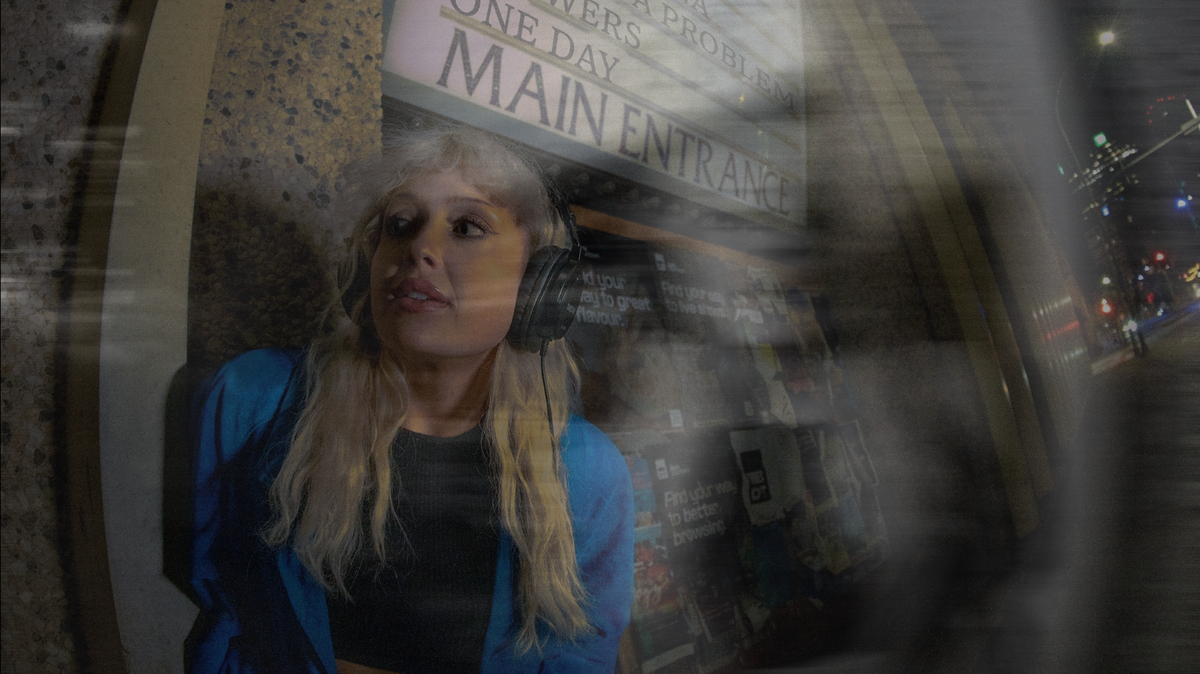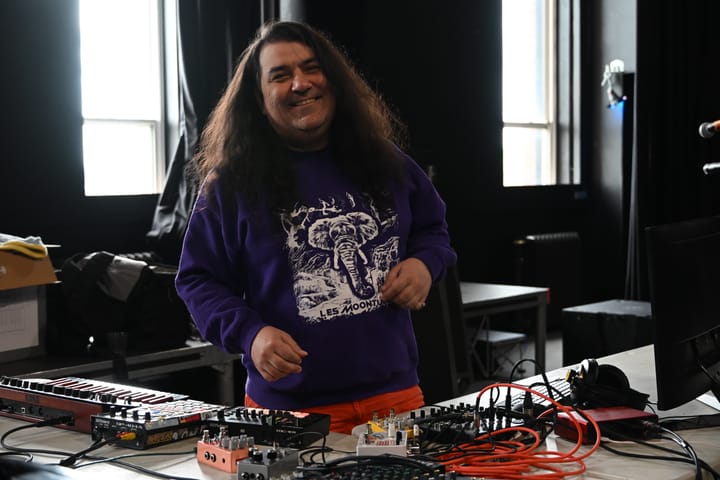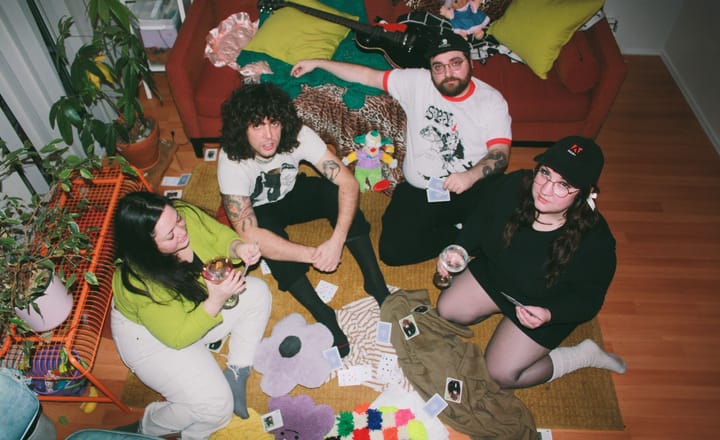
Not Your Final Girl: In Conversation with Floor Cry
I’m not the final girl in your horror movie
But you won't let me die you'd rather do it slowly
When synth-pop dream queen Felicia Sekundiak, known by her musical moniker Floor Cry, began piecing together a debut album, her life was marked by two driving forces: heartbreak and horror.
“At the same time that I was starting to write the album, I was watching all the classics and then going on Shudder and finding lots of cool B-level ones,” Sekundiak says. “I think what really inspired me a lot was the music in the movies. A lot of the ‘80s ones had super cool synth soundtracks. You could just tell they were using instruments in unconventional ways.”
While watching hours of slasher films in her Winnipeg apartment, she felt her life slowly twisting into a horror movie of its own. During the throes of pandemic isolation, a long-term relationship turned sour and eventually fell apart.
Those turbulent times served as material for her first album release, Slasher Flick, a nod to ‘80s horror aesthetics and film tropes. She says the music of Slasher Flick is inspired just as much by horror greats like Lynch and Cronenberg as it is by campy, low-budget thrillers.
The album opens with “1-800-Love,” a cheery synth-bop with the optimism of decades past. If it wasn’t released this year, one might imagine it playing over the speakers in a neon ‘80s retail setting.
Originally released as a single in 2019, the song reflected a time of newfound love and open-heartedness for Sekundiak. But the honeymoon stage doesn’t last forever—in fact, it doesn’t even make it to the next song.
That’s when the killer calls.
“Initially, I was going to write the song ‘Slasher Flick’ around the opening scene in Scream with Drew Barrymore. But then I ended up completely changing the direction of that song and making it a bit more personal,” Sekundiak said. “The phone ringing was meant to be a continuation of ‘1-800-Love,’ but also to reference that opening scene.”
Central to the album is the theme of the ‘final girl.’ Born out of slasher films, the final girl is the last woman standing to confront the killer. From Laurie Strode (Jamie Lee Curtis) in Halloween to Sidney Prescott (Neve Campbell) in Scream, and more recently, Maxine Minx (Mia Goth) in X, she lives to tell the tale after the other, allegedly “impure” women are killed.
The trope was originally conceptualized by the film theorist Carol J. Clover in her 1992 book, Men, Women, and Chain Saws: Gender in the Modern Horror Film. Like many tropes, the final girl reproduces patriarchal ideals on screen. Often, the final girl does not save herself, but rather, a heroic, white knight, male figure steps in to rescue her.
“The image of the distressed female most likely to linger in memory is the image of the one who did not die: the survivor, or Final Girl,” Clover writes. “She alone looks death in the face, but she alone also finds the strength to either stay the killer long enough to be rescued (ending A) or to kill him herself (ending B). But in either case, from 1974 on, the survivor figure has been female.”
Funnily, Sekundiak says she doesn’t fit the mold of the stereotypical final girl one bit.
“Usually, the final girl has some sort of moral superiority. There’s always her friends that get killed off because they’re drinking alcohol or making out in a forest, and then the one ‘innocent’ girl makes it to the end,” she says. “I don’t really fit that description at all.”
But in Slasher Flick, the final girl represents more than a nod to the classic trope—it’s how Sekundiak lyricizes experiences in past relationships.
“In a way, I am a final girl in the sense that the last few years of my life have been extremely hard to get through and have felt like a horror movie in many ways,” she says. “In the song ‘Slasher Flick,’ it’s like I’m saying I’m not the final girl in, I guess, my ex’s horror movie.”
Whether the next main character of the aforementioned horror movie ends up being a final girl is largely out of Sekundiak’s control. Though, in the lyrical, faux cinematic universe of the album’s title track, listeners are clued into the casting call.
Now I know what you are / You were texting her number riding in my car / And I know someone better you should meet / She's fast, and she's shiny and her name's Christine
In any case, as Sekundiak sings, there is no sequel—at least for her.
Compared to Floor Cry’s earlier work, Slasher Flick is far more thematically coherent. While her entire discography is threaded by ‘80s synth and aesthetics, her first full-length album connects previously explored themes of romance, nostalgia, and heartbreak into a larger narrative in line with Sekundiak’s lived experience.
While stringing together this album, Sekundiak reconnected with her frequent musical collaborator: the Minnesota dream pop band, Vansire. Several years ago, the pair bonded after mutually discovering each other on the YouTube Channel, TheLazylazyme, and connecting over Soundcloud.
From there, they became friends and later collaborators on their debut song, “Nice to See You.”
“We continued to stay friends and stay in touch, and then it just became this natural thing where any time they were putting out a release, whether it was an EP or an album, and same with me, we would always write a song for each other,” she says.
Vansire’s Josh Augustin, who happened to be really into Twin Peaks around the time Sekundiak was producing the album, was in the perfect headspace to make a contribution. In “Mahogany,” the album’s interlude, Augustin’s haunting bassline bows to the Lynchian series’ late composer, Angelo Badalamenti.
Stylistically, the album incorporates a host of retro horror flick elements. Layers of synth transport the listener into an era of neon dreams and sappy radio ballads.
Most notably, a blood-curdling scream can be heard on the title track.
As a commitment to the genre, Sekundiak surveyed the best places to let out a scream without a concerned neighbour calling the cops and ended up in her parents’ Winnipeg basement.
“At the time I recorded that, I was already living on my own,” she says. “I texted my mom out of the blue, and I was like, ‘can I come over for like, less than an hour and just record myself screaming at the top of my lungs?’”
After a few takes, she became the scream queen of her own album.
While producing the album, Floor Cry didn’t shy away from the cheesy, perhaps even corny qualities of the horror flicks of the era—instead, she embraced them.
“Some people might find the music cheesy in a lot of them but I think it’s very playful. There’s something very charming about it to me,” she says.
Whether casting herself as a scream queen or final girl, the release of Sekundiak’s debut album is a testament to her living to tell the tale.
From its opening ballad, “1-800-Love,” to its closing dénoument, “One Day,” Slasher Flick creeps through the pleasures of desire and horrors of heartbreak. But unlike the campy thrillers that inspired the album, Floor Cry’s life isn’t spared by some heroic, male character; she’s her very own final girl.
Read more

Sentries: Multifaceted Noise Rock

Step Into Little Stone Crow's World

